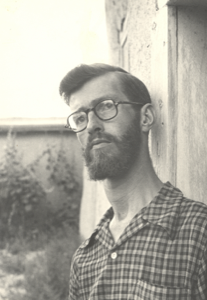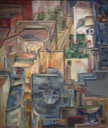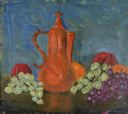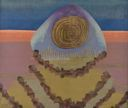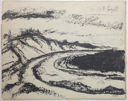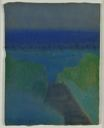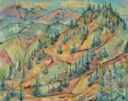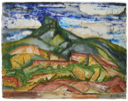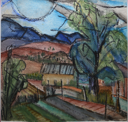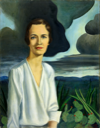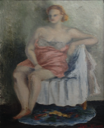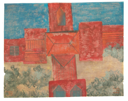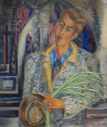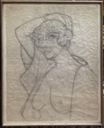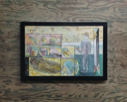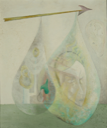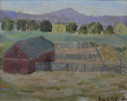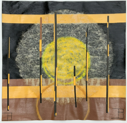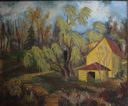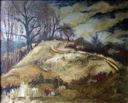Fort Worth Circle
American, (1919–1991)
William Purinton Bomar Jr. worked in many styles of art during the sixty or so years of his life as an artist. He was painting “pure” abstractions in his early 20s, though his early abstractions retained some sense of perspective and contained “objects” if only surreal or symbolic ones. At the same time he continued painting in a representational style, especially portraiture and landscape. His landscapes and still lifes varied from his very individualistic style of realism through various stages of abstraction. Many of his paintings were imaginary still lifes or scenes which contain symbolic elements - webs, arrows, thorns, blossoms, waves, nails (a reference to his mother’s family name), etc. These symbols would recur in various forms throughout his life’s work.
Born in 1919, Bill Bomar started painting at the age of seven. According to his own account he became fascinated with oil painting as a child when the painter Murray Bewley painted his portrait. When his mother took him to a class for children he rejected pencil or watercolor because “they didn’t smell right”. He painted only in oils until the age of sixteen. His first teacher was Fort Worth artist Sallie Blyth Mummert. In 1939 he studied with Santa Fe artist Jozef Bakos. He attended Cranbrook Academy of Art in 1940-41, then the next year (introduced by Bakos) he began studies with American icon John Sloan, both in Santa Fe and New York. He became a good friend of Sloan’s and credited him (in a 1988 interview) with teaching him the art of drawing as a profound “connection of idea, head and hand”. During this same period he became influenced by (and influenced) the group of artists now called the Fort Worth Circle, several of whom became lifelong friends of his. His first exhibition was with some of his Fort Worth Circle compatriots in a group show at the Weyhe Gallery in New York.
In the late 1940s he continued his studies in New York, first with disciplined technical instruction in painting and critiques from the French painter Amadee Ozenfant, and next with the abstract painter Hans Hoffman, of whom Bomar said: “It was a very grand opening up after all that French discipline. What I recall most is establishing tension, and negative and positive space.” By this time he had moved to New York more or less full time, living at the Chelsea Hotel in an apartment across the hall from John Sloan’s. (My father remembered visiting with Bill and Sloan in Bill’s apartment.) Later he moved to a larger studio apartment at the Chelsea. Altogether he lived in New York for almost thirty years, traveling to New Mexico or abroad during the summers, and also frequently to Maine and Cape Cod.
Bill was a very close friend of my parents, who both met him (and each other) through their Fort Worth Circle friends who used to frequently attend soirees at the house of Dickson and Flora Reeder in Fort Worth. I knew him my whole life until his death in 1991 since my parents were also living in New York when I was born. Some of the other Circle artists lived in the city at that time: Marjorie Johnson Lee with her husband Francis, and George Grammer with his wife June. Also of course my mother Sara Shannon Steel. After my parents moved to Connecticut Bill and their other Circle friends in New York visited frequently. Bror Utter was often a guest from Fort Worth and sometimes Lia Cuilty would be in town and come stay with us.
In 1968 Bill bought a house in Ranchos de Taos, NM. It was an old adobe with fantastic views of the surrounding mountains that had formerly been the home of artist Ward Lockwood and his wife. Bill used to say that the ghosts of the Lockwoods haunted the place and would rearrange things in the living room occasionally but I never ran into them myself. By 1972 he had given up his Chelsea apartment and settled permanently in New Mexico, where he lived for the rest of his life. By then my parents had moved back to Texas and after I finished college I would drive out to Taos most years and stay with Bill for part of the summer.
It’s hard to describe how wonderful Bill’s house was. He added a studio and eventually an attached apartment for guests. He also had constructed a separate windowless adobe structure on the premises which he called the “mausoleum”. It served to house the overflow of his huge art collection. Bill’s place was like a Shangri-la to me- the beautiful garden, the patio filled with sculpture, the surrounding mountains, and his wonderful art collection (which today is the core of the OJAC collection). Bill was an amazing collector: some works were by famous artists, others by artists I had never heard of, and of course many by his fellow Fort Worth artists. In many ways it represented a history of the artists he had known in his life- past and present. He was a mentor to many of the young artists in New Mexico and elsewhere. It was great fun to drive around with him and visit their studios. He could be critical, (he would save the most serious criticism for the drive home) but he would encourage them and buy their work. He had an infectious enthusiasm when he saw something he liked.
I’ve seen many fine art collections, but Bill’s had a certain seamless quality that made it particularly personal. It was as if the whole house was a work of art in a kind of casual, non-intimidating way, with the possible exception of the space between the living and dining room which was dominated by a huge glass case containing his mother’s collection of mostly Tang dynasty Chinese ceramics. The Bomar blue gate to his driveway had a sign that read “Bill B. Tang.”
In discussing the life of Bill Bomar it would be remiss not to mention the great personal difficulties he faced. Bill suffered his whole life from Cerebral Palsy which was the result of birth trauma. Fortunately his was relatively mild or he would not have been able to achieve what he did as an artist. His family were financially well off so they could afford extensive physical therapy when he was a child. I’m pretty sure that he had the best treatment that was available at the time. When he was young he walked perfectly well though he often used a cane. He was very tall and when he got going down the sidewalks of New York with his loping gait he was hard to keep up with. He continued to have the ability walk until about 1980 or so, when after a few falls which in some cases were life threatening he reluctantly gave it up and resigned himself to the use of a wheelchair. Luckily by that time motorized wheelchairs had been developed which allowed him a certain degree of independence.
Bill still painted some until near the end of his life but as his coordination deteriorated he was extremely slow, this influenced his decision to adopt collage and later monoprint as artistic mediums. His wonderful eye and artistic vision remained unimpaired and I think that some of the work from this period is equal in quality to the best of his earlier work.
Bomar’s work may be somewhat confusing in terms of the multiplicity of styles that represent his total output, but he himself talked about the general importance of artists exploring different stylistic avenues at the same time. He would say that in spite of the fact that galleries would encourage it as important for artists’ work to be recognizable, it could be risking “burn-out” for an them to pursue only one style. He liked to work on three our four things at the same time, saying that the “conversation” with the work was the essence of his creativity. When one work in progress stopped talking to him, he would give it a rest and switch to another that might have something new to say.
Source: Shannon Steel essay for Texas Moderns: Bill Bomar exhibition, Old Jail Art Center, 2017. (Bomar quotes about his art studies from Deats, Suzanne “Conversation with Bill Bomar” Santa Fe East magazine, Winter/Spring 1988: 5-7.)
A Gate Which Opened Out 1982.029
Abstract on Brown Paper 2008.058
Across the Gorge 1998.025
Alice Reynolds 2010.003
Assault 1987.017
Beach 1993.034
Between Streets 1981.026
Boats in a Maine Harbor 1998.019
Casa Manana 1993.071
Cattails 2002.003
City Scene 1998.024
City Suntrap 1983.016
Colorado Mountain 1981.025
Copper Coffee Pot 1993.032
Dark Sun Trap 2016.001
Dune Beach 1984.030
Fantasy Cloud 2008.059
Fellucas 1993.033
Female Nude Seated (back) 2007.041
Female Nude Torso 2013.015
Gladiolus 1984.007
Gold Sea 1984.028
Head of Dick Reeder 1993.029
Hedgerow to the Sea 1987.028
Italian Landscape 1 (A) 1998.026.01
Italian Landscape 1 (B) 1998.026.02
Italian Landscape 3 (A) 1998.027.01
Italian Landscape 3 (B) 1998.027.02
Jay's Pool 2007.009
Jewel's Feathered Hat 1984.046
Landscape 1993.024
Low Tide 1998.010
Maine Boulder 1998.022
Maine Coast 1998.023
Modigliani-esque Head of Jewel Bomar 1993.022
Mountains 2016.032
Near Coyote 1993.039
New Mexico Garden 1998.021
New Mexico Mountains and Trees 1998.020
Nile at Luxor 1993.020
Olive Slope 1993.035
Plant and Mask 1981.021
Portrait of Jewel Nail Bomar 1982.021
Portrait of Woman with Red Hair 1993.021
Ranch 2006.061
Red Adobe 2006.062
Red Onions 1981.027
Red Rocks 1998.008
Reflections 1981.024
Rita as Medea 1993.026
Rock Cliff 2006.060
Rocks and Trees 1987.024
Rocks and Vegetation 1998.046
Self Portrait as a Young Man 1993.030
Shoreline 1990.038
Side Glance from Rita 1993.036
Southwest by West 1993.037
Squares Involved with Counterpoint 1998.012
Still Life 1993.025
Still Life with Kite 1982.008
Stuff of Dreams 1998.009
Tears 2007.010
Trees in the Fog 1987.018
Untitled 2005.003
Untitled 2024.04
Untitled (barn) painted at age 9 1999.004
Untitled (landscape) 2004.012
Untitled (portrait of a woman) 2009.018
Untitled (yellow sun) 2023.005
When I Dream of Death 2008.057
Where We Walk 1998.011
White Grapes 1987.019
William Kienbusch 1993.019
Willow 1993.031
Winter Road 1993.023
Young Actor 1993.027
